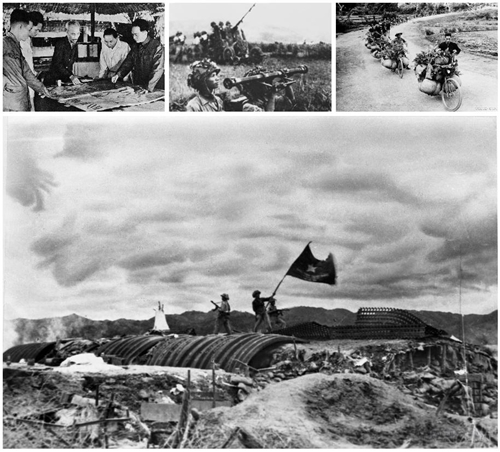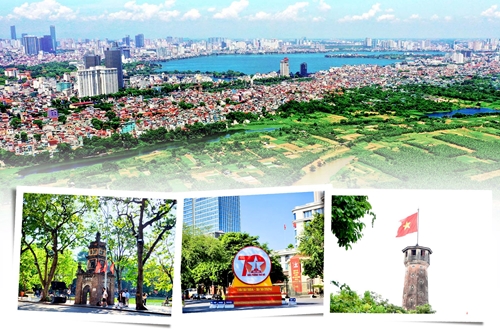One day later, on December 20, President Ho Chi Minh, on behalf of the Democratic Republic of Vietnam Government, called upon the entire population to take part in the resistance war, having affirmed the Vietnamese nation's iron will not to lose the country and not to be enslaved again.
    |
 |
|
With the Dien Bien Phu Victory in 1954, Vietnam forces the French colonialists to sign the Geneva Agreement on July 21, 1954 on the cessation of hostilities in Vietnam and withdraw French troops from the North of Vietnam. |
After the nine-year arduous resistance war, with the unshakable will and the indomitable, intelligent, brave, and creative fighting spirit of the Vietnamese military and people, especially with the Dien Bien Phu Victory in 1954, Vietnam forced the French colonialists to sign the Geneva Agreement on July 21, 1954 on the cessation of hostilities in Vietnam; recognize the independence, sovereignty, and territorial integrity of the three countries of Vietnam, Laos, and Cambodia; and withdraw French troops from the North of Vietnam.
In the light of history and national pride, October 10, 1954 became an indelible mark in the minds of the Vietnamese people. It was the day when Hanoi was liberated after being colonized for nearly a century.
Day of victorious military’s return
Under the terms of this agreement, Hanoi was part of the gathering area of the French troops in 80 days. During those 80 days, the military and people in Hanoi had to continue the fight in the new context to move towards the takeover of the capital.
The French colonialists took advantage of that time to sabotage economic and cultural facilities, lure people to move to the South, cause disorder and make thing grind to a halt. They wanted to leave an exhausted, chaotic city which would decrease the prestige of the Vietnamese resistance government both domestically and internationally.
Knowing in advance the French colonialists' plot, and fully being aware of the scale and importance of taking over Hanoi, the Politburo and the Secretariat of the Party Central Committee assigned comrades Vo Nguyen Giap, Le Van Luong, Xuan Thuy, and To Huu to directly lead the takeover.
On September 17, 1954, according to the Government's resolution, the Hanoi Military Administrative Committee was established to take over the city. Major General Vuong Thua Vu was assigned as the committee’s chairman while Tran Duy Hung was its vice chairman. The Government Council announced policies for the newly-liberated city, policies on religion, and regulations for soldiers, cadres and employees who enter the newly-liberated city; the General Command ordered the military units advancing to liberate Hanoi to maintain order and security in the city, protect the people, foreigners, thoroughly implement the policies and rules set forth by the Government, always keep vigilance, and be ready to crush all provocations and sabotage plots.
After the diplomatic struggle to demand the French colonialists withdraw from Hanoi on time, ensure the principle of orderly and safe transfer, without sabotage and without interrupting the activities of the people's lives, on September 30, 1954, the two sides signed the Agreement on the military transfer of Hanoi.
On October 2, 1954, they signed the Agreement on the administrative transfer of Hanoi. The government sent police, guards, and administrative teams to Hanoi to prepare for the takeover of the city.
The capital takeover ceremony was held solemnly at the Cot Co stadium, with the presence of many leaders and the people of Hanoi.
The takeover of the capital was a great success. The Vietnamese side safely and quickly took over 129 offices, public works, factories, hospitals, and schools, including military positions and important headquarters. The people's lives remained normal and stable. The electricity, water, transport and communications sectors operated smoothly and regularly; political security and social order were ensured properly; schools, hospitals, cultural agencies, press agencies, among others continued to operate normally under the government's management.
From "City for Peace" to "Creative City"
In 1999, Hanoi was recognized as a "City for Peace" by UNESCO. Since then, Hanoi has remained the only capital in the Asia-Pacific region to receive that title.
The title of "City for Peace" that the UNESCO granted to Hanoi showed a recognition by the international community of the positive contributions of the capital city in the struggle for peace, and its efforts to develop a city of peace.
    |
 |
|
Hanoi - "City for Peace" and "Creative City" (Photo: qdnd.vn) |
Exactly 20 years after achieving the title of "City for Peace," in October 2019, Hanoi continued to be honored as a member of the UNESCO's Creative Cities Network in the field of design.
As a creative city in the field of design, Hanoi has set general goals by 2025. It strives to develop rapidly and sustainably to become a green urban area, a smart and modern city with high competitiveness in the country and in the region. By 2030, Hanoi is expected to become a “green-smart-modern” city, developing dynamically, effectively, and have high competitiveness in the region and the world.
By 2045, Hanoi is envisioned to ensure a high quality of life for people, achieve comprehensive and sustainable economic, cultural and social development; is a globally connected city with international competitiveness.
After joining the "UNESCO Creative Cities Network" and implementing initiatives and commitments to promote creative design activities in cultural-economic-social development programs, for the last five years, Hanoi has organized many activities related to creative design. The activities have attracted the participation of many domestic and international units, organizations and individuals, gradually bringing creative design activities into all aspects of life.
Creative products are present across the city, showing a solid foundation for Hanoi's development based on creative design. In particular, cultural festivals, events, and typical creative activities held in the city have attracted a large number of people who do creative jobs and people in general.
Joining the "UNESCO Creative Cities Network" is the first but important step towards the goal of enhancing the position, creating a new and more attractive image for Hanoi, opening up many opportunities and potential in urban reconstruction.
Attaching importance to preserving cultural heritage, improving infrastructure and encouraging creativity, Hanoi is gradually implementing sustainable development goals, contributing to building a modern, civilized and livable city, in line with the United Nations 2030 Agenda for Sustainable Development and the Politburo's Resolution 15-NQ/TW on the direction and tasks of developing Hanoi Capital to 2030, with a vision to 2045.
Source: VNA